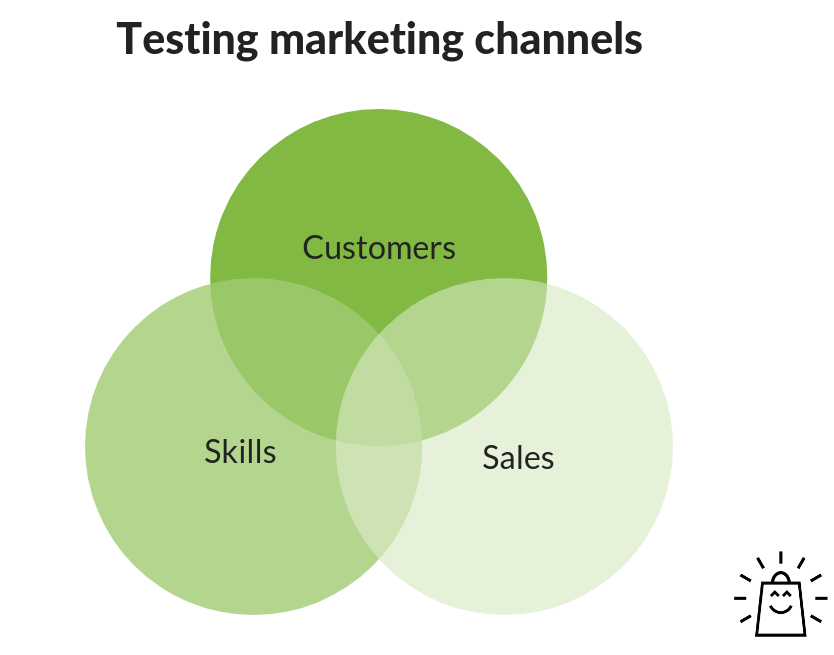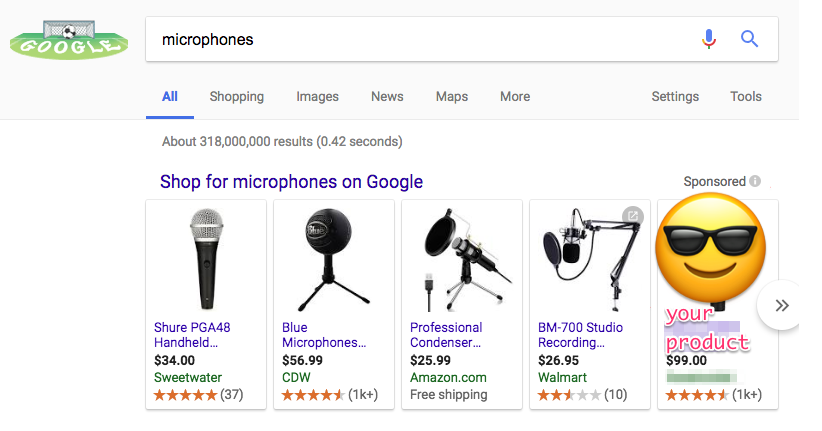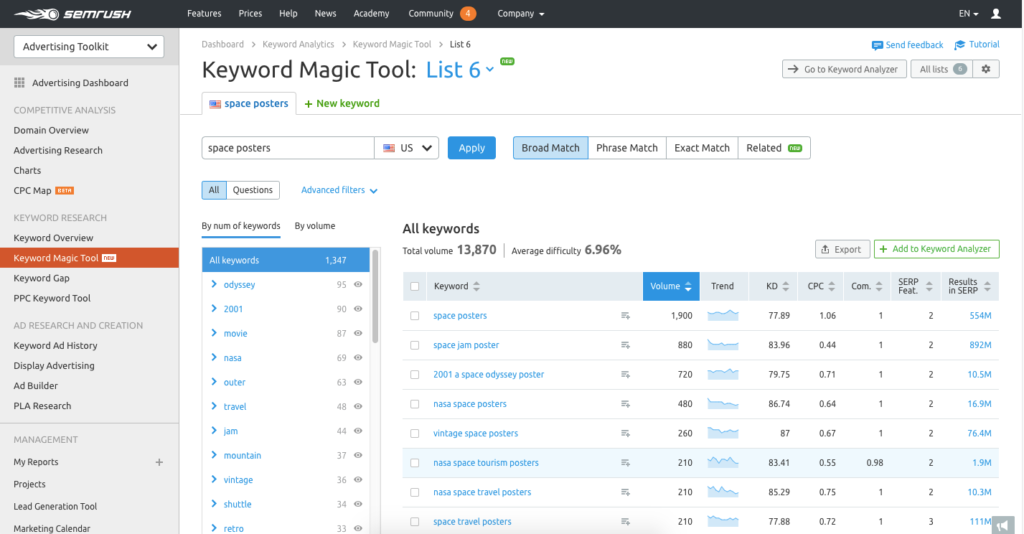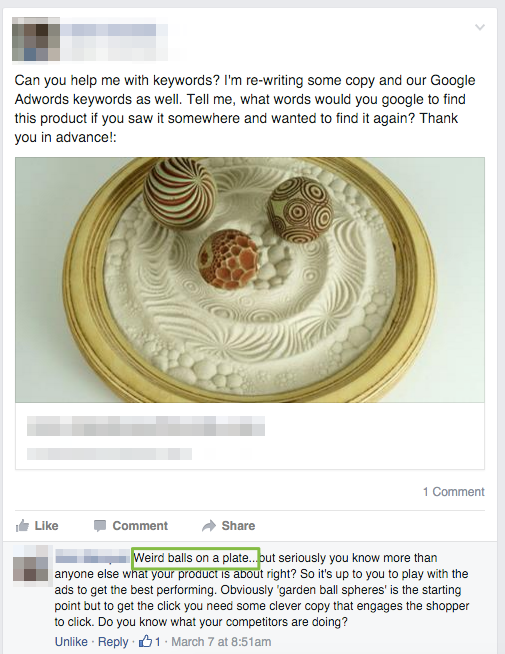In the last few years Google Shopping has gotten a lot more popular. Google sees that it works and shows more product listing ads.
And those success stories attracted more online stores interested in running their own campaigns.
But like any marketing channel, no matter how promising it looks, you can only find out if it works for you by testing it.
In this article, I’ll share 11 Google Shopping case studies from large and small businesses. But I’ll start with 3 key questions that will help you to determine if Google Shopping is interesting for your business.
Be sure to read through until the end because I’ve included a bonus for readers that do want to try out this marketing channel for their store.
Here is what we will cover in these articles:

Let’s explore them all three into more detail.
1. Reaching Customers with Google Shopping
Google Shopping works by showing Product Listing Ads (or PLAs) in the Google Search results. And your customers probably use Google to find stuff.

These are some warning signs that indicate it will be tough to reach customers via Google Shopping:
#1 – No or a very low amount of monthly searches
So the key question is: are your potential customers using Google to find the products that you are selling?
You can check that for yourself with SEMrush. It’s a paid keyword research tool, but the free version gives you a good preview:

That table will give you a good overview of the number of monthly searches. You can also see other related terms with their according volume.
If you’d like the things you can discover, you can always do more in-depth keyword research.
This list should already give you a little indication if there is some potential for your store.
If you don’t find a lot, or the numbers don’t look promising, a couple of things might be happening:
If the most relevant keyword you can come up with has no results or only 20 searches/month, there simply aren’t enough people searching for your products.
On the other hand, if your top keywords have big search volumes, like 20,000 searches /month, you know the potential is there.
Car speakers, for example, has 33,100 monthly searches. That means that there will be a lot more specific searches for other types of speakers, different price ranges or brands.
#2 Can’t find good keywords
If you have a hard time coming up with a keyword that people would use, chances are that your potential customers will struggle as well. Probably they will find your products in another way than with a Google Search.

If your product is hard to explain, Google Shopping is not a good channel for you. This also indicates that you will struggle when it comes to SEO, as the search demand simply isn’t there.
Some industries generally will have a harder time with this, as their products are hard to describe:
- Unique products like the art of custom jewelry
- One of a kind product, vintage or second-hand products
- T-shirts businesses: your angle needs to be reflected in the search query. Dropshippers beware: if you’re trying to sell your brand and no one knows it, people won’t search for it either.
#3 Google Shopping is supported in your country
Google Shopping is available in a lot of different countries.
The following countries are supported: At the time of writing these are the supported countries: Argentina, Australia, Austria, Belgium, Brazil, Canada, Chile, Colombia, Czech Republic, Denmark, France, Germany, Hong Kong, India, Indonesia, Ireland, Israel, Italy, Japan, Mexico, Netherlands, New Zealand, Norway, Philippines, Poland, Portugal, Russia, Saudi Arabia, Singapore, South Africa, South Korea, Spain, Sweden, Switzerland, Taiwan, Thailand, Turkey, Ukraine, United Arab Emirates, United Kingdom, United States, and Vietnam.
If your country isn’t supported, you could try to run regular text ads with Google Ads.
If you’ve run into the problems described above, you could explore other types of advertising. Facebook Ads are a good alternative for most of the product categories mentioned above. They are more focused on awareness.
2. Necessary Skills for Google Shopping
Technical
The biggest challenge to starting with Google Shopping is setting up your product feed.
It usually involves a lot of trial and error: tweaking excel files, re-uploading product feeds and a lot of prayers.
You don’t need to be a tech expert to make it work, but you should be comfortable with making changes to your ecommerce platform.
Analytical
Once your campaigns are up and running you’ll start to see the first results. Your main goal is to get more money out compared to what you’re putting in.
Money in << Money out
To get there you’ll need to pay attention to all the metrics that Google Ads provides: how much do you pay per click, what’s the click-through rate, which products are showing, which aren’t, etc.
Optimizing Google Shopping campaigns is a subject in itself. But to keep track of what you’re changing and how you can accomplish certain goals you’ll need to be an analytical person.
You’ll need to dig through your analytics to discover what’s working and what isn’t.
Creativity
Google Shopping is very numbers-driven. But there is some room for creativity: coming up with great product titles that combine the right keywords with the intent of a potential customer or creating product pictures that stand out from competitors.
If you’re missing one or more of these skills, you can always outsource a specific part to focus on what you’re best at. You could have someone set up your Google Shopping campaigns, while you figure out how to optimize them.
3. Can Google Shopping deliver traffic and generate sales?
Because of the competitive nature of e-commerce, it’s not that easy to find stores that openly share which channels are generating sales for them.
But here I do want to share some results of that I’ve seen. Below you’ll find a mix of results from our readers, case studies I’ve found online, a client of mine and some case studies by Google.
Google has a lot of slick produced case studies and they obviously only cherry-pick the best results. Since it was hard to find other Google Shopping case studies I’ve decided to include them to show you the different product categories where stores are getting results.
Case study #1: Syght Gaming Glasses
Syght Gaming Glasses was launched as an experiment by Shopify. It was a brand new store so they knew they needed traffic and sales. Launching a Google Shopping campaign was part of their marketing tactics.
Results:
- Clicks: 153
- Average cost per click: $0.73
- Click-through rate (CTR): 2.03%
- Sales: 8
- Cost: $112.26
- Customer acquisition cost (CAC): $14,03
- Total revenue: $319.92
- Total profit: $207.66
The store isn’t operational anymore as of late 2018, but I wanted to keep it in.
Source: How I Imported Gaming Glasses With Alibaba and Made $2,416.51 in 5 Weeks
Case study #2: Client in the beauty industry
These results come from a client of mine that runs advertising campaigns on a lot of different platforms, including Search and Shopping campaigns on Google Ads.
I’ve included this store to show the potential of well-managed Shopping campaigns, especially compared to Search campaigns. The results below apply to campaigns that focus on generic search queries. This means that they don’t include searches for the brand name. Customers that look for the brand name already know the store and are much more likely to convert at a lower cost than people that are looking for generic keywords.
Results:
- Customer acquisition cost (or CAC): 60% lower for Shopping vs Search campaigns
- Return on Ad Spend (or ROAS): Shopping campaigns deliver 2x the revenue for the same advertising budget compared to Search campaigns
- Conversion rate (or CR): Traffic from Shopping campaigns converts at 3 times the rate of Search campaigns
ROAS is calculated as total revenue / total cost. Keep in mind that it is important to calculate the Return On Investment (ROI) for your campaigns, as that indicates how much profit you make for each sale. (ROI = total profit / total cost)
From the results above it’s obvious that the Shopping campaigns bring a lot more return vs the Search campaigns.
The goal for this client is to spend as much on Shopping campaigns as possible. But these do have an upper limit.
So for this client, we’re maximizing the sales volume we get from Google Shopping while bringing in additional (more expensive) sales via the regular text ad campaigns.
Case study #3: Store in the furniture industry (reader)
A reader of the blog sells furniture and was happy to share some recent stats. When he launched his store his only sales came from Google Shopping campaigns. Now he has diversified his traffic and he gets his customers through a couple of different channels. Here are his results for his Google Shopping campaigns for the last 30 days.
Results:
- Clicks: 265
- Average cost per click: $0.33
- CTR: 0.53%
- Sales: 12
- Cost: $87.96
- Customer acquisition cost: $7.33
- Revenue: $1,248.22
Case study #4: Wild Dill (reader)
Wild Dill is the online store from Tina, one of our readers. She sells organic, eco-friendly and fair trade baby products. Her store is a great place to go if you’re looking for curated natural baby toys, organic baby clothing, or any other natural alternatives to mainstream children’s products.
Wild Dill ran a Google Shopping campaign as part of a test last year. Despite seeing some sales come in, they discovered other marketing channels that delivered them better results.
So with some tweaking, the results below probably could have been further improved (sales at a lower cost or more sales volume).
Results:
- Clicks: 332
- CTR: 1.45%
- CPC: $0.47
- Cost: $156
- Sales: 4
- Customer acquisition cost: $39
- Conversion rate: 1.25%
Case study #5: ECCO Shoes (from the web)
Ecco Shoes sells men’s and women’s shoes and was looking for a way to increase visibility and lower their customer acquisition cost.
They were already running Search ads but they knew potential customers would react well to seeing an image on an actual product. As a result, adding their products to Google Shopping worked very well for Ecco Shoes.
Results:
- New visitors: +24%
- Customer acquisition cost: -14%
- Conversion rate: +28%
- Average order value: +38%
Source: Digital Gearbox case study
Case study #6: Paper Culture (Google)
Paper Culture sells personalized recycled stationery like cards, posters or decals.
They could reach potential customers on Google that were looking for specific designs. Even though it’s a competitive industry with big brands, the product listing ads allow them to show their unique product designs and compete with bigger brands.
Results:
- Decreased cost-per-lead (CPL) by 50%
- 3x the ROI when compared to their other online channels
Source: Google Adwords blog post
Case study #7: PUBLIC Bikes (Google)
PUBLIC Bikes sells bicycles and cycling accessories. They turned to Google shopping as a way to scale their marketing efforts and get in front of more potential customers.
Results:
For every $1 invested in Shopping campaigns, PUBLIC Bikes was able to see 2x the ROI as compared to their other online channels.
Source: Google Adwords blog post
Case study #8: TravelSmith Outfitters (Google)
TravelSmith Outfitters sells travel clothing and accessories. They turned to Google Adwords (both Shopping and Search ads) to get in front of the right customers with the right products as they search on Google.
Results:
- Traffic: +10%
- Orders: +35%
- Sales: +26%
- Return on ad spend: +20%
- Customer acquisition cost decreased
Source: Google Shopping TravelSmith Outfitters case study (pdf)
Case study #9: Empire Covers (Google)
Empire Covers sells protective covers for cars, trucks, boats, RVs, and motorcycles.
They already advertised heavily on Google. But when they started running Shopping campaigns it allowed them to show prices next to product images. This allowed for comparison shopping which resulted in lower bounce rates, more time spent on the site, and better conversion rates.
Results:
- Cost per click: -11%
- Customer acquisition cost: -36%
Source: Google Shopping Empire Covers case study (pdf)
Case study #10: Vineyard vines (Google)
Vineyard vines sells a wide variety of men’s, women’s, and children’s apparel. They were looking at Google Shopping for an increase in revenue and capture more real estate on the search engine results page.
Two benefits, in particular, stood out for them:
- Product listing ads cut through the clutter, the images in the paid search results pop off the page.
- The ability to bid differently on products or categories with different ROIs
Results:
- Revenue: 4% overall revenue growth
- Click through rate: 160% higher than non-branded search
- Conversion rate: 84% higher than search & 112% higher than display
- ROI is higher than any other digital channel
Source: Google Shopping vineyard vines Covers case study (pdf)
Case study #11: Front End Audio (Google)
Front End Audio offers recording and live-sound equipment. They weren’t happy with their returns on their advertising campaigns: the conversion rate was low and the cost-per-conversion was extremely high.
That’s why they tried to advertise their products on Google Shopping.
Results:
- Tripled CTR
- Raised conversion rate
- Reduced customer acquisition cost by 75–80 percent
- Saw product listing ads (PLAs) account for 15 percent of total sales within a few weeks
Source: Google Shopping Front End Audio case study (pdf)
I’ve shown you which stores can benefit from using Google Shopping, what it takes to get up and running with them and show you how other stores have made Google Shopping work for them.
Hopefully, this is enough to make up your mind whether you should add it to your to-do list.
My premium training course
If you like this post but want to go through the Google Shopping setup and optimization in more detail? Check out my Google Ads course. Through a series of videos, you’ll go from scratch to having the first sales come in via your Shopping campaigns. The feedback so far has been really great so I encourage you to check it out!
